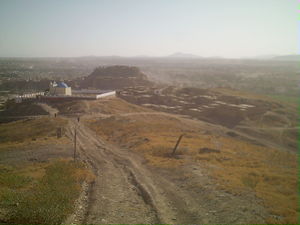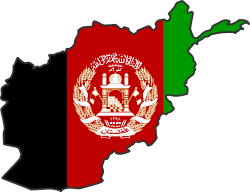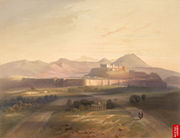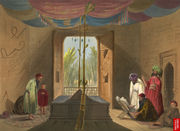Ghazni
For the Province of Ghazni see Ghazni Province
| Ghazni غزنین or غزنی |
|
|---|---|
| — City — | |
 |
|
 Ghazni
|
|
| Coordinates: | |
| Country | |
| Province | Ghazni Province |
| District | Ghazni District |
| Elevation | 2,219 m (7,280 ft) |
| Population (2006) | |
| - Total | 141,000 |
| Central Statistics Office of Afghanistan | |
| Time zone | Afghanistan Standard Time (UTC+4:30) |
Ghazni (Persian: غزنی - Ġaznī; historically known as غزنین / Ġaznīn and غزنه / Ġazna) is a city in central Afghanistan, with an approximate population of 141,000 people. It is the capital of Ghazni Province, situated on a plateau at 7,280 feet (2,219 m) above sea level. It is linked by highways with Qalat to the south-west, Kabul to the northeast and Gardez to the east.[1]
Contents |
Ethnography
The population of Ghazni City is multicultural and multi-ethnic, with approximately 50% Tajiks, 25% Pashtuns, 20% Hazaras, and a small number (approx. 5%) of Hindus.[2]
History

| History of Afghanistan | |||||||||||||||||
|---|---|---|---|---|---|---|---|---|---|---|---|---|---|---|---|---|---|
 |
|||||||||||||||||
| See also | |||||||||||||||||
| Ariana · Khorasan | |||||||||||||||||
| Timeline | |||||||||||||||||
|
Pre-Islamic period
|
|||||||||||||||||
|
Islamic conquest
|
|||||||||||||||||
|
Modern history
|
|||||||||||||||||
|
|
Ghazni was founded sometime in antiquity as a small market-town and is mentioned by Ptolemy.[3] According to Legends it was founded by Raja Gaj of Yadu Dynasty around 1500 B.C.[4] In the 6th century B.C., the city was conquered by the Achaemenid king, Cyrus II, and incorporated into the Persian empire. Ghazni City was a thriving Buddhist center up until the 7th century A.D. In 683 A.D., Arab armies brought Islam to the nearby regions. Yaqub Saffari from Zaranj reigned over the vast region. From 994 to 1160, after the city was rebuilt by Yaqub's brother, it became the dazzling capital of the Ghaznavid Empire, which encompassed much of northern India, Persia and Central Asia. Many iconoclastic campaigns were launched from Ghazni into India, resulting in the large scale destruction of ancient temples, libraries and palaces. The Ghaznavids took Islam to India and returned with fabulous riches taken from both Indian princes and temples. Contemporary visitors and residents in Ghazni wrote with wonder of the ornateness of the buildings, the great libraries, the sumptuousness of the court ceremonies and of the wealth of precious objects owned by Ghazni's citizens.
Although the city was sacked in 1151 by the Ghorid Ala'uddin, it soon became their secondary capital in 1173, and subsequently flourished once again. Between 1215–1221, Ghazni was managed by the Khwarezmid Empire, during which time it was destroyed by the Mongol armies of Genghis Khan, led by his son Ögedei Khan.[5].
Ghazni City is famous for its minarets built on a stellar plan. They date from the middle of the twelfth century and are the surviving elements of the mosque of Bahramshah. Their sides are decorated with intricate geometric patterns. Some of the upper sections of the minarets have been damaged or destroyed. The most important mausoleum located in Ghazni City is that of Sultan Mahmud. Others include the Tombs of poets and scientists, such as the Tomb of Al Biruni. The only ruins in Old Ghazni retaining a semblance of architectural form are two towers, about 43 m (140 ft) high and 365 m (1,200 ft) apart. According to inscriptions, the towers were constructed by Mahmud of Ghazni and his son.

The Buddhist site at Ghazni is known as Tapar Sardar and consists of a stupa on a hilltop, surrounded by a row of smaller stupas.[6] Nearby, an 18 metre long Parinirvana (reclining) Buddha was excavated in the late 'sixties and early 'seventies. It is believed to have been built in the 8th Century A.D. as part of a monastery complex.[7] In the 1980s, a mud brick shelter was created to protect the sculpture, but the wood supports were stolen for firewood and the shelter partially collapsed. In 2001, the Taliban blew the Buddha up, believing it to be idolatrous.[8]
During the First Anglo-Afghan War, the city was stormed and taken over by the British forces on July 23, 1839 in the Battle of Ghazni. The Civil war in Afghanistan and the continued conflict between the Taliban and the Northern Alliance during the 1990s put the relics of Ghazni in jeopardy.
Ghazni's strategic position, both economically and militarily, assured its revival, albeit without its dazzling former grandeur. Through the centuries the city has figured prominently as the all-important key to the possession of Kabul.
Water
Ghazni City is located in an area of extreme drought.[1] Recently, one of the gates on a fifty-year-old dam on the Jikhai River broke, bringing up concerns among the inhabitants of Ghazni city about the water supply. The dam serves as a good source of irrigation water to Ghazni City and the surrounding agricultural areas.[9] Nearby rivers have a history of flooding and causing severe damage and death.[10] Efforts have begun to remedy this.[11]
Points of interest

- Citadel
- Minarets of Ghazni
- Palace of Sultan Mas'ud III
- Tomb of Sebuktigin
- Mausoleum of Sultan Mahmud
- Mausoleum of Sanai
- Museum of Islamic Art
- Tapa Sardar Excavations
Notables from Ghazna
- Sadiq Ali Khan Tanoli (sons named Feroz Khan, Sanjay Khan, Akbar Khan (director),Indian film actors,
- Hajweri Ghaznawi
- Mahmud of Ghazni
- Sanai
- Hassan Ghaznavi
- Mullah Faiz Mohammad Katib
- Farrukhi Sistani, Manuchehri Damaghani, Abul-fazl Bayhaqi (royal poets and writers who lived during the Ghaznavids period)
Sister cities
See also
References and footnotes
- ↑ 1.0 1.1 "Geography". http://www.afghanfriends.net/ghazni/geography.html. Retrieved 2007-07-15.
- ↑ "District Profile" (PDF). http://www.aims.org.af/afg/dist_profiles/unhcr_district_profiles/centra/ghazni/ghazni_city.pdf. Retrieved 2007-07-15.
- ↑ Guinta, Roberta. "GAZNÈ (or GÚazna, GÚazn^n)". Encyclopædia Iranica (Online Edition ed.). United States: Columbia University. http://www.iranica.com/newsite/articles/v10f4/v10f431.html. Retrieved January 2008.
- ↑ Ghazni to Jaiselmer (Pre-medieval History of the Bhatis), pp 93, Hari Singh Bhati, Publisher: Hari Singh Bhati, 1998, Printers: Sankhala Printers, Bikaner
- ↑ "Ghazni". The Columbia Electronic Encyclopedia, 6th ed. Copyright © 2007, Columbia University Press. http://www.infoplease.com/ce6/world/A0820705.html.
- ↑ Trudy Ring, Robert M. Salkin, Sharon La Boda (1996) International Dictionary of Historic Places: Asia and Oceania v.5, P.279, Taylor & Francis, ISBN 1-884964-04-4
- ↑ A note on the Parinirvana Buddha at Tapar Sardar M. Taddei (1974) South Asian archaeology 1973: papers from the second International Conference of the Association for the Promotion of South Asian Archaeology in Western Europe, Brill Archive, ISBN 90-04-04189-3
- ↑ Afghan Buddha destruction revealed 15/03/01 BBC News Site
- ↑ "Ghazni's Zanakhan Dam damaged". http://southasianmedia.net/cnn.cfm?id=372763&category=Services&Country=AFGHANISTAN. Retrieved 2007-07-15.
- ↑ River "Dam burst swamps Ghazni city of Afghanistan". Pakistan Times. http://www.pakistantimes.net/2005/03/30/top9.htmJikhai River. Retrieved 2007-07-15.
- ↑ "Ghazni". GlobalSecurity.org. http://www.globalsecurity.org/military/world/afghanistan/ghazni.htm. Retrieved 2007-07-15.
- ↑ Sister Cities International
 This article incorporates text from a publication now in the public domain: Chisholm, Hugh, ed (1911). Encyclopædia Britannica (Eleventh ed.). Cambridge University Press.
This article incorporates text from a publication now in the public domain: Chisholm, Hugh, ed (1911). Encyclopædia Britannica (Eleventh ed.). Cambridge University Press.
External links
- Map of Ghazni district
- Dupree, Nancy Hatch (1977) [1st Edition: 1970]. An Historical Guide to Afghanistan (2nd Edition, Revised and Enlarged ed.). Afghan Tourist Organization. http://www.zharov.com/dupree/index.html.
- Ghazni.org
- 1911 encyclopedia entry
- The City Of Ghazni
- Columbia Encyclopedia (Sixth Edition) - Mahmud of Ghazna
- Encyclopaedia Britannica (Online Edition) - Mahmud
- Encyclopaedia Britannica (Online Edition) - Ghaznavid Dynasty
- Encyclopaedia Britannica (Online Edition) - Ghaznavids and Ghurids
- Columbia Encyclopedia (Sixth Edition) - Muhammad of Ghor
- Mahmud Ghaznavi's 17 invasions of India
- Mahmud Ghazni
- History of Iran: Ghaznevid Dynasty
- Rewriting history and Mahmud of Ghazni
|
|||||